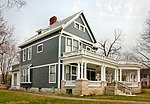Marion Cemetery Receiving Vault
Body snatchingBuildings and structures completed in 1879Buildings and structures in Marion, OhioBurial monuments and structuresCemeteries in Marion County, Ohio ... and 6 more
Gothic Revival architecture in OhioLimestone buildings in the United StatesNational Register of Historic Places in Marion County, OhioTombs of presidents of the United StatesTourist attractions in Marion County, OhioWarren G. Harding

The Marion Cemetery Receiving Vault is a funerary structure in the main cemetery of Marion, Ohio, United States. Constructed in the 1870s, this receiving vault originally fulfilled the normal purposes of such structures, but it gained prominence as the semipermanent resting place of Marion's most prominent citizen, U.S. President Warren G. Harding.
Excerpt from the Wikipedia article Marion Cemetery Receiving Vault (License: CC BY-SA 3.0, Authors, Images).Marion Cemetery Receiving Vault
Vernon Heights Boulevard,
Geographical coordinates (GPS) Address Nearby Places Show on map
Geographical coordinates (GPS)
| Latitude | Longitude |
|---|---|
| N 40.576111111111 ° | E -83.122083333333 ° |
Address
Vernon Heights Boulevard
Vernon Heights Boulevard
43302
Ohio, United States
Open on Google Maps







